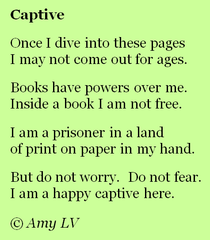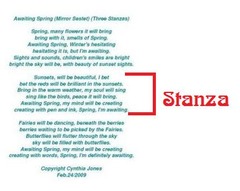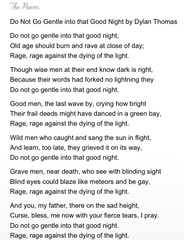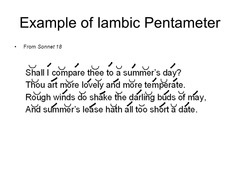AP Literature - Poetry Test Terms
5.0(2)
5.0(2)
Card Sorting
1/38
Earn XP
Description and Tags
Terms that will appear on the December Poetry Unit Test
Study Analytics
Name | Mastery | Learn | Test | Matching | Spaced |
|---|
No study sessions yet.
39 Terms
1
New cards
Alliteration
Repetition of initial consonant sounds
2
New cards
Apostrophe
A figure of speech that directly addresses an absent or imaginary person or a personified abstraction, such as liberty or love.
3
New cards
Assonance
Repetition of vowel sounds
4
New cards
Consonance
Repetition of consonant sounds
5
New cards
End rhyme
Rhyme that occurs at the end of two or more lines of poetry
6
New cards
Exact rhyme
the repetition of the same stressed vowel sound as well as any consonant sounds that follow the vowel
7
New cards
Internal rhyme
a rhyme involving a word in the middle of a line and another at the end of the line or in the middle of the next.
8
New cards
Metaphor
A comparison without using like or as
9
New cards
Onomatopoeia
A word that imitates the sound it represents.
10
New cards
Personification
the giving of human qualities to an animal, object, or idea
11
New cards
Rhythm
Pattern of stressed and unstressed syllables
12
New cards
Simile
A comparison using "like" or "as"
13
New cards
Slant rhyme
an approximate rhyme derived by substituting assonance or consonance for true rhyme
14
New cards
Ballad stanza
a poetic form with quatrains rhyming ABAC or ABAB; 8 syllables in the A lines, 6 in the others (Amazing Grace, America the Beautiful, etc.)
15
New cards
Couplet
Two consecutive lines of poetry that rhyme (or a 2-line stanza)
16
New cards
Heroic couplet
two end-stopped iambic pentameter lines rhymed aa, bb, cc with the thought usually completed in the two-line unit

17
New cards
Quatrain
a four-line stanza with any combination of rhymes

18
New cards
Sestina
a fixed verse form consisting of six stanzas of six lines each, normally followed by a three-line envoi
The six end-words in each line are repeated throughout the poem in a regular pattern
The six end-words in each line are repeated throughout the poem in a regular pattern
19
New cards
Sonnet
a fourteen-line lyric poem, usually written in rhymed iambic pentameter
20
New cards
Stanza
a section or a division of a poem; specifically, a grouping of lines of poetry

21
New cards
Villanelle
a nineteen-line poem consisting of five tercets(triplets) and a quatrain, Lines 1 and 3 alternately repeated at the ends of each stanza

22
New cards
Blank verse
Poetry written in unrhymed iambic pentameter

23
New cards
Foot
the basic unit of rhythmic measurement in a line of poetry
24
New cards
Free verse
has no regular beat or meter, but rather depends on the individual poet's sensitivity to the rhythm of natural speech
25
New cards
Iambic pentameter
occurs in a ten-syllable line starting with alternating unstressed and stressed syllables throughout the line

26
New cards
Meter
the basic rhythmic structure of a line within a poem
27
New cards
Shakespearean Sonnet/English Sonnet
Sonnet containing three quatrains and a couplet with the rhyme scheme ABAB, CDCD, EFEF, GG
28
New cards
Petrarchan/Italian Sonnet
An octave and a sestet. Octave must rhyme abba abba; the rhyme scheme of the sestet can vary.
29
New cards
synecdoche
Figurative language in which the speaker uses a part of a thing/person to stand for the whole (nice wheels = I like your car; all hands on deck = the whole worker is needed, not just the hands)
30
New cards
metonymy
Figurative language in which you mean to reference someone/something by stating something associated with that person/thing (Hollywood = the movie industry, The Crown = the monarchy)
31
New cards
hyperbole
Overblown exaggeration
32
New cards
antithesis
A sentence with 2 parallel clauses that present contrasting ideas (Not that I loved Caesar less, but that I loved Rome more)
33
New cards
symbol
an object that takes on significance because it represents an abstract idea
34
New cards
pantoum
A poem written in quatrains in which two lines are repeated in the next stanza
35
New cards
sestet
a 6-line stanza
36
New cards
octave
an 8-line stanza
37
New cards
dramatic monologue
A poem in which the speaker is a fictional character who is addressing an implied audience (usually another fictional character)
38
New cards
narrative
a poem that has a plot (tells a story)
39
New cards
lyric
Most poems are this type - a single speaker talks about their thoughts/feelings in a brief poem